NASA-X Returns to Arizona
Firebird East Raceway – October 25, 2009

After a long drought from NASA-X (NASA’s version of autocross) events in the valley, the series returned to Arizona on October 25th as 88 entrants came out to Firebird East for the first event in over five years. Since NASA-X is relatively new to Arizona, this event was in the planning stages for many months in effort to adapt NASA’s classing system to the already solid foundation of autocrossers in the state, and of course, familiarize the NASA staff which has been handling racing and HPDE events for several years. Thanks to years of veteran experience on behalf of the organizers and supporters, along with the positive outlook from the competitors, the event went off without a hitch and provided some excellent feedback to the NASA crew for future events. Oh, and the competitors had heck of a lot of fun on Firebird East as well!
The Basics
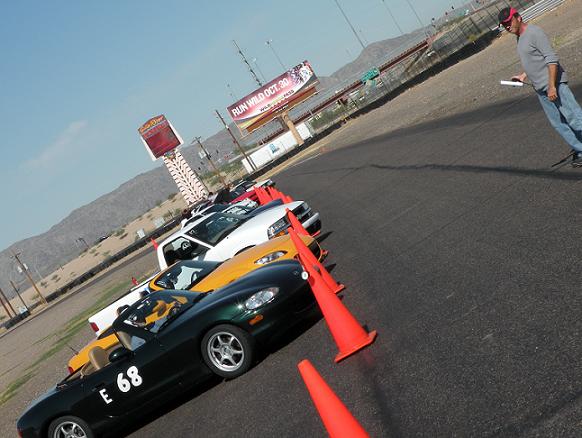
The front straight at FIR East was used for the grid area at the NASA-X event.
For those of you that did not attend the NASA-X event, covering the basics are essential so the remainder of this wrap up makes sense! NASA-X, or “NASA Cross” is NASA’s format for autocross competition. NASA-X can take place on a skidpad, or in this case, Firebird East’s roadcourse. Due to NASA’s experience and infrastructure for holding track-oriented events, having the NASA-X event on the FIR East course, which allows higher speeds and a longer distance, was easy enough for the NASA crew.
The rules are simply a modified set of the Time Trial or Performance Touring rules. Rather than having Performance Touring B (PTB), or Time Trial B (TTB), a NASA-X competitor would participate in NASA-X B (NXB). The points system for classing remains intact, but there are a few minor differences in car classing, points assessments and rules in order to make the vehicle buildup process make sense for an autocross type of course design. Just as an example, all aero mods are free (no points) in NASA-X, with the thought that the lower speeds of autocross won’t result in the same gain you’d see on a higher speed road course. Of course, that simply means some people are willing to take full advantage of the free mods list to save every tenth, as seen below!
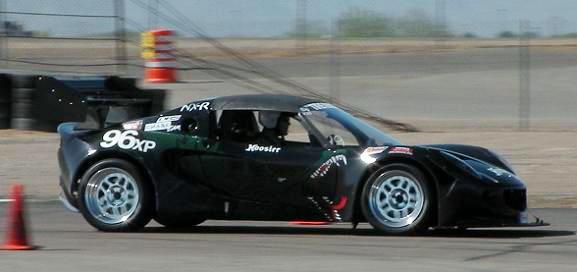
Many people run higher downforce setups for NASA-X to help with grip at lower speeds
Lastly, NASA-X events involve cones–big rubber orange ones! In the spirit of the autocrossing concept, cones (or pylons) are placed throughout the racing surface, be it a parking lot or road course, for several reasons. The first being to make the driving actually difficult, by introducing slaloms, Chicago Boxes, gates, kinks, pointer cones, etc. Secondly, it’s to help slow the cars down to a more common speed seen in autocross events, which targets highway speeds or less. Surely there are exceptions, but by introducing features and corners with cones, the course is essentially different everytime, which is inline with the spirit of autocrossing.
The Business
Of course, the big question with any competitive event–especially autocross–is how the classing system shakes out. Is it fair? Does it even make any sense? Road racers and time trialers from NASA have had the benefit of a large sampling size nationwide, as well as five years to shake out and perfect the TT and PT rules. While the NASA-X rules are constantly being updated and maintained like TT and PT, the latest version has never been implemented, tested or used in a competitive format in Arizona. Seeing as Arizona has fielded multiple national champion caliber autocrossers, many of which attended the NASA-X event, a baseline example for which direction people need to go with their vehicle selection and builds was set on October 25th.
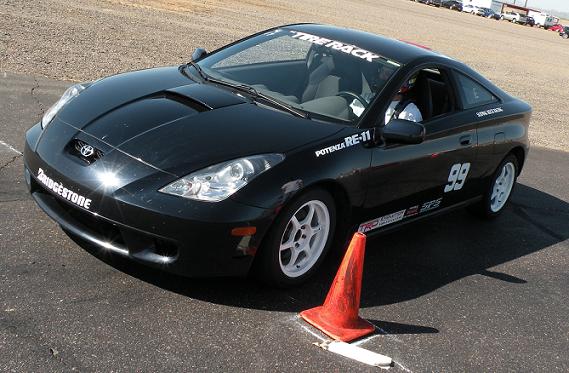
A NXE Toyota Celica lines up for a quick run, which spanned just under a full lap of Firebird East
One factor that has to be considered is the course layout. While TT and PT take place on road courses, NASA-X can vary from a road course layout as seen here, to a parking lot layout. Both formats will possibly require different setups and the points assessment from NASA will possibly make more sense on one layout compared to another. One example would be, the +3 points for a final drive modification, which can be more or less influential depending on the course size and design. Again, that’s what provides some excitement to the NASA-X events as competitors have to weight their options for how to use those points carefully.
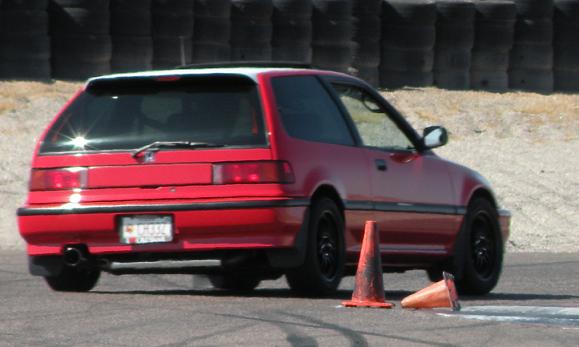
Richard Vela turns the last corner before the finish.
One interesting note is that four of the nine classes were won on street tires (NXB, NXD, NXE, NXF)–something that would rarely happen in other autocross organizations, with the exception of the classes that only allow street tires obviously. A multiple-time autocross National champion took 3rd place in NXR, behind a shifter kart and a home-built autocross “machine” which utilizes a CVT transmission. I guess when they say NXR is open rules, they really mean it!
NXC shook out as expected, with national champion autocrossers Brian Peters and Doug Rowse taking first and second place in a BMW 330i, which used many of its points on tire size and choice alone. Clint Child took the win in NXB in an Mistubishi EVO on street tires, 0.3sec ahead of Tage Evanson in a supercharged Mazda Miata on race tires. If that doesn’t scream diversity, and capture the spirit of NASA-X, then I don’t know what does! NXE was the largest group with 17 people in class, and the top three cars were a BMW 325i, a Toyota Celica and a Mazda Miata. If anything is strikingly similar to the Time Trial and Race results from NASA, it’s the variance in vehicle makes/models throughout the results.
So how did the time spread look for the winners among the nine classes? Let’s take a look:

As mentioned above, the competition course was a little less than the full length of Firebird East, with the start being on the front straight and the finish ending up just before pit exit. Each driver was allowed a parade lap (slow speed) at the beginning of the run session, with four competition runs that counted towards the overall results.
The Best
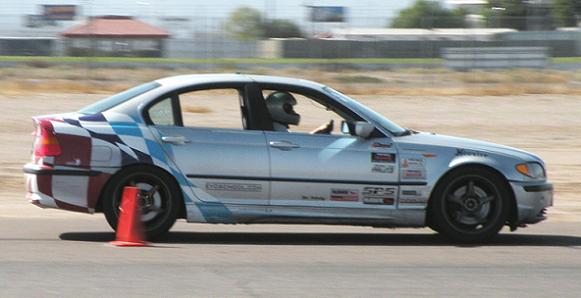
Two autocross national champions shared this BMW 330 and took 1st and 2nd in NXC
Unlike other forms of autocross where there are an excessive number of classes with just a few cars in each, as usual, NASA’s system with nine classes means all 88 competitors would have plenty of people to measure up to! The car counts were as follows: NXR – 7, NXS – 6, NXU – 6, NXA – 5, NXB – 12, NXC – 14, NXD – 11, NXE – 17, NXF – 7. And what you’ve all been waiting for, the winners of each class:
NXR
- Mark Eddy – 63.820 – KGB Spy 125 Kart
- Dan Hawrylkiw – 64.998 – Zink Z-19
- Mark Huffman – 65.324 – Lotus Elan
NXU
- David Schotz – 69.101 – Chevy Corvette
- Larry Petrucci – 70.763 – Pontiac Firebird
- Joel Schotz – 73.022 – Chevy Corvette
NXS
- Steve Eymann – 69.695 – Porsche GT3
- Ted Lewis – 72.763 – Lotus Elan
- Travis Barnes – 77.082 – Subaru WRX
NXA
- Dave Young – 74.186 – BMW M3
- Chris Black – 77.225 – Pontiac Trans Am
- Hector Espiriti – 79.519 – Chevy Corvette
NXB
- Clint Child – 72.793 – Mitsubishi Evo
- Tage Evanson – 73.116 – Mazda Miata
- Ben Clement – 74.080 – Mitsubishi Evo
NXC
- Brian Peters – 71.084 – BMW 330i
- Doug Rowse – 72.590 – BMW 330i
- Brian Weikert – 74.749 – BMW M3
NXD
- Jay Balducci – 74.074 – Mazda Miata
- Robert Rose – 75.234 – Mazda Miata
- George Sklyarevsky – 76.589 – Mazda RX8
NXE
- Elliot Speidell – 73.671 – BMW 325i
- David Rock – 75.489 – Toyota Celica
- Matt Soeffner – 76.227 – Mazda Miata
NXF
- Manfred Reysser – 77.429 – Toyota Celica
- Travis Gianelli – 78.518 – VW Jetta
- Jason Miller – 78.579 – Honda Accord
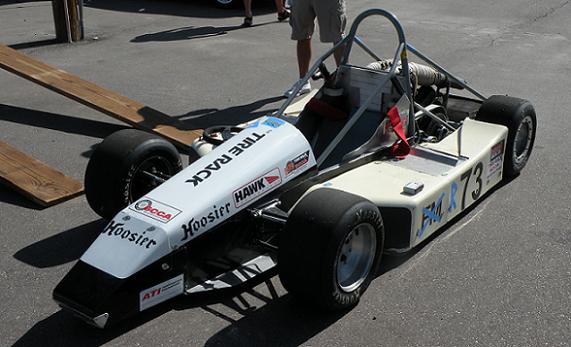
Dan Hawrylkiw's Zink Z-19 that took second place in NXR
Looking Forward
Perhaps the second best part about the NASA-X event (first being, the driving!), is the fact that no one was required to work. Of course, this meant that NASA had to hire corner workers to shag cones all day, which all of them were more than happy to do. Perhaps the biggest problem of the day arose when the organizers realized just a few more workers would keep things flowing just a little quicker, or there would be less delay, thus resulting in more driving. The result of that is well, more workers of course, but also a possible multi-level system for registration that NASA guarantees is much more simple than the classing system! (Note the sarcasm!)
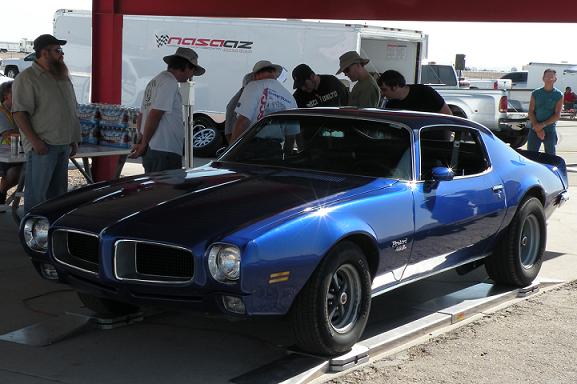
Between run sessions, many drivers put their cars on the scales to check competition weight
Potentially, when and if there are future NASA-X events, there will be three options for registration:
- NASA Member Pricing – Discounted from the highest price due to the existing NASA membership.
- Non-NASA Member Pricing – Slightly more, yet still extremely competitive with any other non-member autocross entry.
- Worker Pricing – If you are willing to work for a run group, you get a discount on entry fee. Plain and simple. Hard efforts shall be rewarded!
That is just one such idea for a pricing structure to keep NASA’s event progressive, flexible, and aligned with other NASA HPDE and Racing events. Speaking of events, currently there are a minimum of two NASA-X events planned for 2010 already. Given the pilot event was just held on October 25th, the NASA crew has already secured two possible dates for NASA-X events. Given NASA’s ability to safely hold road-course based events, look for the majority of the NASA-X events to be held on Firebird’s courses.
Lastly, a big thanks goes out to all the NASA workers, drivers and spectators who came out to make this event a huge success. Putting together what is essentially the first event of its kind wasn’t an easy task by any means, but aside from the minor hiccups along the way, NASA Arizona is thankful to have so many dedicated drivers and workers willing to put on and support these events. Thanks for reading the NASA Arizona Wrap Up!
